Land Use/Land Cover Changes in the Tlemcen Region (Algeria) and Classification of Fragile Areas
Abstract
1. Introduction
2. Study Area
- The concentration of rainfall during the cold period (autumn and winter)
- An apparent drought during the hottest months (summer)
- The length of the dry season is on average four months, covering the summer season.
3. Material and Methods
3.1. Material
3.2. Image Pre-Processing
- ENVI 5.3 image processing software for geometric image corrections and color compositions;
- eCognition software for image classification: this works somewhat differently than most software that classifies images. Instead of working at the pixel level, i.e., using pixels as fundamental classification objects, eCognition first generates its own objects, called “image objects”, by using a parametrizable segmentation process. Then these objects are classified using one of the techniques available in the software, for example, range of spectral values, shape, neighborhood;
- The GIS software, ArcGIS 10.5 for digitizing and creating land use maps and change maps.
3.3. Fieldwork and Validation of the Classifications Obtained
LULC Change Mapping
- Calculation of rates of change (global rate of change and annual rate of change): according to the equation proposed by [61] (1) and [62]) (2) frequently used to measure growth between two given periods [63,64,65]. The rates of change in the area of LULC classes between the years 1987 and 2017 were calculated as follows:Tg = (S2 − S1) × 100/S1Tc = (lnS2 − lnS1) × 100/(t2 − t1) × lne
- S1 the area of a unit area class at date t1;
- S2 is the area of the same area unit class at date t2.
- Transition matrix: The transition matrix provides the opportunity to highlight LULC changes over a given period [66,67]. The values in the columns represent the proportions of areas occupied by each land-use class at a time (j) and those in the rows at the initial time (i). The cells of the matrix contain the value of a variable that has changed from an initial class (i) to a final class (j) during the period under consideration. It is acquired by crossing the LULC maps of 1987, 1995, 2005, and 2017 and made feasible by the “Intersect polygons” algorithm of the Geoprocessing extension under ArcGIS 10.5. The modifications are of three categories: (i) progressions which correspond to the increase in area of a class (positive change), (ii) regressions which correspond to the change from one class to another in terms of a decrease in its initial area (negative change), (iii) and stability which corresponds to the absence of change in the thematic class during the study period.
- Typology of changes: Based on the transition matrix, the observed changes were classified according to the process types: stability, mutation (from one type of forest to another, or from farm to urban areas), degradation (decrease of the vegetal cover), degradation by fire, development (cultivation or urbanization of former natural areas), reclamation (densification of the vegetal cover). Each of these processes was then detailed at the starting date of the period where the percentage of the area was calculated for each type.
4. Results
4.1. Validation of Classifications and Mapping Results
4.2. Analysis of the Changes of LULC
4.2.1. Areas and Average Spatial Expansion Rate
4.2.2. The Period 1987–1995
4.2.3. The Period 1995–2005
4.2.4. The Period 2005–2017
4.3. Transition Matrix
4.3.1. From 1987 to 1995: Destruction of Scrubland and Forests by Large Fires
4.3.2. From 1995 to 2005: Revegetation of Burnt Rocky Land, Abandoned Agricultural Land and Degraded Land
4.3.3. From 2005 to 2017: Stabilization of Natural Vegetation and Extension of Arboriculture
5. Discussion
5.1. The Regression of the Forest Area and the Progression of Rocky Outcrops Following Fires
5.2. Progression of the Surface Area of Forest
5.3. Progress of the Agricultural Area
5.4. Progression of the Built Areas
5.5. Synthesis
6. Conclusions
Author Contributions
Funding
Institutional Review Board Statement
Informed Consent Statement
Data Availability Statement
Acknowledgments
Conflicts of Interest
References
- Scarascia-Mugnozza, G.; Oswald, H.; Piussi, P.; Radoglou, K. Forests of the Mediterranean region: Gaps in knowledge and research needs. For. Ecol. Manag. 2000, 132, 97–109. [Google Scholar] [CrossRef]
- Conard, S.G.; Hartzell, T.; Hilbruner, M.W.; Zimmermam, G.T. Changing fuel management strategies-The challenge of meeting new information and analysis needs. Int. J. Wildland Fire 2001, 10, 267–275. [Google Scholar] [CrossRef]
- Balzan, M.V.; Hassoun, A.E.R.; Aroua, N.; Baldy, V.; Bou Dagher, M.; Branquinho, C.; Dutay, J.-C.; El Bour, M.; Médail, F.; Mojtahid, M.; et al. Ecosystems. In Climate and Environmental Change in the Mediterranean Basin–Current Situation and Risks for the Future; First Mediterranean Assessment Report; Cramer, W., Guiot, J., Marini, K., Eds.; Union for the Mediterranean, Plan Bleu, UNEP/MAP: Marseille, France, 2020; pp. 323–468. [Google Scholar]
- Gauquelin, T.; Michon, G.; Joffre, R.; Duponnois, R.; Génin, D.; Fady, B.; Dagher-Kharrat, M.B.; Derridj, A.; Slimani, S.; Badri, W. Mediterranean forests, land use and climate change: A social-ecological perspective. Reg. Environ. Chang. 2018, 18, 623–636. [Google Scholar] [CrossRef]
- Lionello, P.; Abrantes, F.; Gacic, M.; Planton, S.; Trigo, R.; Ulbrich, U. The climate of the Mediterranean region: Research progress and climate change impacts. Reg. Environ. Chang. 2014, 14, 1679–1684. [Google Scholar] [CrossRef]
- Loizidou, M.; Giannakopoulos, C.; Bindi, M.; Moustakas, K. Climate change impacts and adaptation options in the Mediterranean basin. Reg. Environ. Chang. 2016, 16, 1859–1861. [Google Scholar] [CrossRef]
- Pausas, J.G. Changes in fire and climate in the eastern Iberian Peninsula (Mediterranean basin). Clim. Chang. 2004, 63, 337–350. [Google Scholar] [CrossRef]
- Tramblay, Y.; Llasat, M.C.; Randin, C.; Coppola, E. Climate change impacts on water resources in the Mediterranean. Reg. Environ. Chang. 2020, 20, 3. [Google Scholar] [CrossRef]
- Barbero, M. Témoignage: Pierre Quézel et les montagnes méditerranéennes/Testimony: Pierre Quézel and Mediterranean mountains. Ecol. Mediter. 2018, 44, 23–29. [Google Scholar]
- Keeley, J.E.; Bond, W.J.; Bradstock, R.A.; Pausas, J.G.; Rundel, P.W. Fire in Mediterranean Ecosystems: Ecology, Evolution and Management; Cambridge University Press: Cambridge, UK, 2011. [Google Scholar]
- Mouillot, F.; Rambal, S.; Limousin, J.; Longepierre, D.; Kheder Chiraz, B.; Ouelhazi, B. Mediterranean ecosystems facing global change: Resilient or close to tipping point? In The Mediterranean Region under Climate Change: A Scientific Update; Thiébault, S., Moatti, J.-P., Eds.; IRD Editions: Marseille, France, 2016; pp. 349–361. [Google Scholar]
- Garcia-Ruiz, J.M.; Lasanta, T.; Ruiz-Flano, P.; Ortigosa, L.; White, S.; González, C.; Martí, C. Land-use changes and sustainable development in mountain areas: A case study in the Spanish Pyrenees. Landsc. Ecol. 1996, 11, 267–277. [Google Scholar] [CrossRef]
- Lasanta-Martínez, T.; Vicente-Serrano, S.M.; Cuadrat-Prats, J.M. Mountain Mediterranean landscape evolution caused by the abandonment of traditional primary activities: A study of the Spanish Central Pyrenees. Appl. Geogr. 2005, 25, 47–65. [Google Scholar] [CrossRef]
- Cohen, M.; Decaudin, B.; Llausas, A. Concilier les Objectifs de Protection de la Nature et de Lutte contre l’Incendie. In Proceedings of the 25th International Cartographic Conference, Paris, France, 3–8 July 2011; Ruas, A., Ed.; Paper CO-107. International Cartographic Association: Berna, Switzerland, 2011; p. 8. [Google Scholar]
- FAO. Negotiating a Sustainable Future for Land: Structural and Institutional Guidelines for Land Resources Management in the 21st Century; FAO/UNED: Rome, Italy, 1997. [Google Scholar]
- Papanastasis, V.P. Land use changes. In Mediterranean Mountain Environment; UNEP/MAP: Marseille, France, 2012; pp. 159–184. [Google Scholar]
- Sitayeb, T.; Benabdeli, K. Contribution à l’étude de la dynamique de l’occupation des sols de la plaine de la Macta (Algérie) à l’aide de la télédétection et des systèmes d’information géographique. Comptes Rendus Biol. 2008, 331, 466–474. [Google Scholar] [CrossRef]
- McNeill, J.R. The Mountains of the Mediterranean World: An Environmental History; Cambridge University Press: Cambridge, UK, 1992. [Google Scholar]
- Labani, M.M.; Rezaee, R. The importance of geochemical parameters and shale composition on rock mechanical properties of gas shale reservoirs: A case study from the Kockatea Shale and Carynginia Formation from the Perth Basin, Western Australia. Rock Mech. Rock Eng. 2015, 48, 1249–1257. [Google Scholar] [CrossRef]
- Alcaraz, C. Etude Géobotanique du Pin d’Alep dans le Tell Oranais. Ph.D. Thesis, Université de Montpellier, Montpellier, France, 1969; p. 183. [Google Scholar]
- Alcaraz, C. La Végétation de l’Ouest Algérien. Ph.D. Thesis, Université de Perpignan, Perpignan, France, 1982; p. 415. [Google Scholar]
- Boudy, P. Economie Forestière Nord-Africaine-Tome 1: Milieu Physique et Milieu Humain; Larose, E., Ed.; CIRAD: Paris, France, 1948. [Google Scholar]
- FOSA. L’Étude Prospective du Secteur Forestier en Afrique, Algérie; FAO: Rome, Italy, 2000; p. 60. [Google Scholar]
- Kadik, B. Aperçu sur sols et la végétation des pineraies d’Eghti (Sidi-Bel-Abbes). Annal. Rech. For. Algérie 1986, 1, 7–22. [Google Scholar]
- Missoumi, A.; Mederbal, K.; Abedelli, K. Apport des SIG dans la prévention et la lutte contre les incendies de forêt. Exemple de la forêt domaniale de Kounteidat, Algérie. For. Méditer. 2002, 23, 11–22. [Google Scholar]
- Velez, R. Protection Contre les Incendies de Forêt: Principes et Méthodes d’Action; CIHEAM: Série B: Etudes et Recherches, No 26; Options Méditerranéennes; IFFN: Zaragoza, Spain, 1999. [Google Scholar]
- Zahira, S.; Hadj, B. L’Algérie: Une région méditerranéenne très sensible aux incendies de foret. Territorium 2017, 1, 177–186. [Google Scholar] [CrossRef][Green Version]
- Zeraia, L. Essai d’Interprétation Comparative des Données Écologiques, Phénologiques et de Production Subéro-Ligneuse dans les Forêts de Chêne-Liège de Provence Cristalline (France Méridionale) et d’Algérie. Ph.D. Thesis, University of Aix-Marseille, Marseille, France, 1981; p. 367. [Google Scholar]
- Barbero, M.; Bonin, G.; Loisel, R.; Quézel, P. Changes and disturbances of forest ecosystems caused by human activities in the western part of the Mediterranean basin. Vegetatio 1990, 87, 151–173. [Google Scholar] [CrossRef]
- Boer, M.M.; Puigdefábregas, J. Predicting potential vegetation index values as a reference for the assessment and monitoring of dry land condition. Int. J. Remote Sens. 2003, 24, 1135–1141. [Google Scholar] [CrossRef]
- Boer, M.M.; Puigdefábregas, J. Assessment of dry land condition using spatial anomalies of vegetation index values. Int. J. Remote Sens. 2005, 26, 4045–4065. [Google Scholar] [CrossRef]
- Holm, A.M.; Cridland, S.W.; Roderick, M.L. The use of time-integrated NOAA NDVI data and rainfall to assess landscape degradation in the arid scrubland of Western Australia. Remote Sens. Environ. 2003, 85, 145–158. [Google Scholar] [CrossRef]
- Le Houérou, H.N. Climate change, drought and desertification. J. Arid Environ. 1996, 34, 133–185. [Google Scholar] [CrossRef]
- Ludwig, J.A.; Tongway, D.J. Viewing rangelands as landscape systems. In Rangeland Desertification; Springer: Berlin/Heidelberg, Germany, 2000; pp. 39–52. [Google Scholar]
- Paruelo, J.M.; Sala, O.E.; Beltrán, A.B. Long-term dynamics of water and carbon in semi-arid ecosystems: A gradient analysis in the Patagonian steppe. Plant Ecol. 2000, 150, 133–143. [Google Scholar] [CrossRef]
- Ramade, F. Dictionnaire Encyclopédique de l’Écologie et des Sciences de l’Environnement; Ediscience International: Marseille, France, 1993. [Google Scholar]
- Le Coz, J. Espaces Méditerranéens et Dynamiques Agraires. État Territorial et Communautés Rurales; Options Méditerranéennes: Série B. Etudes et Recherches, n° 2; CIHEAM: Montpellier, France, 1990; p. 393. [Google Scholar]
- Bouiadjra, S.E.B.; Zerey, W.E.; Benabdeli, K. Étude diachronique des changements du couvert végétal dans un écosystème montagneux par télédétection spatiale: Cas des monts du Tessala (Algérie occidentale). Physio-Géo. Géogr. Phys. Environ. 2011, 5, 211–225. [Google Scholar] [CrossRef]
- Gaouar, A. Hypothèses et réflexions sur la dégradation des écosystèmes forestiers dans la région de Tlemcen (Algérie). For. Méditer. 1980, 2, 131–146. [Google Scholar]
- Meslinée Bestaoui, K. Contribution à une Étude Écologique et Dynamique de la Végétation des Monts de Tlemcen par une Approche Cartographique; Faculté des Science, Université Abou Bekr Belkaïd: Tlemcen, Algiers, 2009. [Google Scholar]
- Zenagui, N. Synthèse Phylogénétique des Communautés Végétales dans les Matorrals des Monts de Tlemcen. Ph.D. Thesis, Université de Tlemcen, Algiers, Algeria, 2017; 245p. [Google Scholar]
- Martín-Ortega, P.; Segur, M. FAO and Plan Bleu, 2018. State of Mediterranean Forests 2018; Food and Agriculture Organization of the United Nations: Rome and Plan Bleu, Marseille, 2018. Available online: http://planbleu.org/en/publications/state-mediterranean-forests-2018 (accessed on 15 September 2019).
- Lu, D.; Mausel, P.; Brondizio, E.; Moran, E. Change detection techniques. Int. J. Remote Sens. 2004, 25, 2365–2401. [Google Scholar] [CrossRef]
- Mas, J. Une revue des méthodes et des techniques de télédétection du changement. Can. J. Remote Sens. 2000, 26, 349–362. [Google Scholar] [CrossRef]
- Abdelguerfi, A. Mises en Œuvre des Mesures Générales pour la Conservation In Situ et Ex Situ et l’Utilisation Durable de la Biodiversité en Algérie Bilans des Expertises (Tome 2); Plan d’Action et Stratégie Nationale sur la Biodiversité Projet ALG/97/G31, Rapport de synthèse; Ministère de l’Aménagement du Territoire et de l’Environnement: Alger, Algiers, 2003; p. 109. [Google Scholar]
- Letreuch-Belarouci, A.; Medjahdi, B.; Letreuch-Belarouci, N.; Benabdeli, K. Diversité floristique des subéraies du parc national de Tlemcen (Algérie). Acta Bot. Malacit. 2009, 34, 77–89. [Google Scholar] [CrossRef]
- Organisation de Cooperation et de Developpement Economiques (OCDE). Stratégies Nationales de Développement Durable: Bonnes Pratiques dans les Pays de l’OCDE; Edition de l’OCDE; OCDE: Paris, France, 2006; 38p. [Google Scholar]
- Loukkas, A. Atlas des Parcs Nationaux Algériens; Ministère Agriculture et Développement Rural, Direction des Forêts: Alger, Algiers, 2006; p. 96. [Google Scholar]
- Tlemcen, P. Plan de Gestion (2006–2010) Rapport de Ministère de l’Agriculture et du Développement Rural, PNT; Ministère Agriculture et Développement Rural: Alger, Algiers, 2009. [Google Scholar]
- Benabadji, N.; Benmansour, D.; Bouazza, M. La flore des monts d’Ain Fezza dans l’ouest algérien, biodiversité et dynamique. Sci. Technol. C Biotechnol. 2007, 26, 47–59. [Google Scholar]
- Siba, A. Contribution à l’Étude du Bilan Floristique dans les Matorrals Sud et Nord de Tlemcen. Ph.D. Thesis, University of Aboubekr Belkaïd, Tlemcen, Algiers, 2016; p. 257. [Google Scholar]
- Andrieu, J. Dynamique des Paysages dans les Régions Septentrionales des Rivières-du-Sud (Sénégal, Gambie, Guinée-Bissau). Ph.D. Thesis, University Paris Diderot, Paris, France, 2008; pp. 7–532. [Google Scholar]
- Ducrot, D. Méthodes d’Analyse et d’Interprétation d’Images de Télédétection Multi-Sources. Extraction de Caractéristiques du Paysage. Habilitation à Diriger des Recherches. Ph.D. Thesis, INP, Toulouse, France, 2005. [Google Scholar]
- Bolon, P.; Chassery, J.-M.; Cocquerez, J.-P.; Demigny, D.; Graffigne, C.; Montanvert, A.; Philipp, S.; Zéboudj, R.; Zerubia, J.; Maître, H. Analyse d’Images: Filtrage et Segmentation; Masson: Paris, France, 1995. [Google Scholar]
- Derrar, I. Contribution à la Correction Radiométrique des Images d’ALSAT-1: Application de la Méthode Dite Calibration Indirecte; Mémoire de magister; Univ. Sciences et Technologie d’Oran Mohamed Boudiaf: Bir El Djir, Algiers, 2014; p. 109. [Google Scholar]
- Corbane, C.; Baghdadi, N.; Chevrel, S. Application d’une méthode de classification orientée objet pour la cartographie de l’occupation du sol: Résultats sur ASTER et Landsat ETM. Rev. Fr. Photogramm. Télédétect 2004, 175, 13–26. [Google Scholar]
- Ballais, J.-L.; Barussaud, E.; Cohen, M.; Raymond, R.; Thommeret, N. Dynamiques des Paysages, Érosion et Développement Durable dans les Montagnes Méditerranéennes. Programme de Recherche, Paysages et Développement Durable; Rapport final d’activité; Cohen, M., Ed.; LADYSS: Paris, France, 2008; p. 74. [Google Scholar]
- Achbun, A.; Mansour, M.; Layelmam, M.; Smiej, M.F. Etude comparative de la classification orientée objet d’une image SPOT 5 pour la cartographie de l’occupation du sol via eCognition® 9. Geo Obs. 2011, 9, 13. [Google Scholar]
- Delahaye, A. Classification Multiéchelle d’Images à très Haute Résolution Spatiale Basée sur une Nouvelle Approche Texturale. Ph.D. Thesis, Faculté des Lettres et Sciences Humaines, Université de Sherbrooke, Sherbrooke, QC, Canada, 2016. [Google Scholar]
- Benaissa, H.; Benabdeli, K. Evaluation de l’impact du parcours sur la végétation du Parc national de Tlemcen (Algérie nord-occidentale). Geo-Eco-Trop J. 2019, 43, 129–136. [Google Scholar]
- Project, F.R.A. Forest Resources Assessment 1990: Survey of Tropical Forest Cover and Study of Change Processes; Food & Agriculture Organization: Rome, Italy, 1996. [Google Scholar]
- Bernier, B. Introduction à la Macroéconomie; La Découverte: Paris, France, 1992; p. 217. [Google Scholar]
- Mama, V.J.; Oloukoi, J. Évaluation de la précision des traitements analogiques des images satellitaires dans l’étude de la dynamique de l’occupation du sol. Télédétection 2003, 3, 429–441. [Google Scholar]
- Oloukoi, J.; Mama, V.J.; Agbo, F.B. Modélisation de la dynamique de l’occupation des terres dans le département des collines au Bénin. Télédétection 2006, 6, 305–323. [Google Scholar]
- Soro, G.; Anouman, D.; BI, T.G.; Srohorou, B.; Savane, I. Caractérisation des séquences de sècheresse météorologique à diverses échelles de temps en climat de type soudanais: Cas de l’extrême nord-ouest de la Cote d’Ivoire. Larhyss J. 2014, 18, 107–124. [Google Scholar]
- Bamba, I.; Mama, A.; Neuba, D.; Koffi, K.J.; Traore, D.; Visser, M.; Sinsin, B.; Lejoly, J.; Bogaert, J. Influence des actions anthropiques sur la dynamique spatio-temporelle de l\’occupation du sol dans la province du Bas-Congo (RD Congo). Sci. Nat. 2008, 5, 49–60. [Google Scholar] [CrossRef]
- Schlaepfer, R. Analyse de la dynamique du paysage. Fiche Enseign. 2002, 4, 11. [Google Scholar]
- Bouhraoua, R. Situation Sanitaire de Quelques Forêts de chêne-Liège de l’Ouest Algérien: Étude Particulière des Problèmes Posés par les Insectes. Ph.D. Thesis, University of Tlemcen, Tlemcen, Algiers, 2003. [Google Scholar]
- AEFCO. Description des Peuplements de la Forêt Domaniale de Zarifet; AEFCO: Peyton, CO, USA, 1912. [Google Scholar]
- Boudy, P. Economie Forestière Nord-Africaine. Tome 2: Monographies et Traitements des Essences Forestières; Editions Larousse: Paris, France, 1950; p. 878. [Google Scholar]
- Weise, D.R.; Biging, G.S. A qualitative comparison of fire spread models incorporating wind and slope effects. For. Sci. 1997, 43, 170–180. [Google Scholar]
- Lasanta, T.; Arnáez, J.; Pascual, N.; Ruiz-Flaño, P.; Errea, M.; Lana-Renault, N. Space–time process and drivers of land abandonment in Europe. Catena 2017, 149, 810–823. [Google Scholar] [CrossRef]
- Office National de la Météorologie (ONM) et de la Direction Générale des Forêts (DGF). Réduction D’échelle et Modélisation Climatique avec Une Application à la Gestion des Forêts en Algérie; ClimaSouth—Technical Paper 4; Projet national: Algiers, Algeria, 2018; p. 57. [Google Scholar]
- Berriah, A. Les Reboisements de Chêne Liège dans l’Ouest Algérien: Bilan et Perspectives d’Amélioration; Mémoire de Magister; University Abou Bakr Belkaïd: Tlemcen, Algiers, 2015; p. 158. [Google Scholar]
- Messaoudene, M.; RabhiI, K.; Megdoud, A.; Sarmoun, M.; Dahmani-Megrerouche, M. Etat des lieux et perspectives des cédraies algériennes. For. Méditer. 2013, 34, 341–346. [Google Scholar]
- Belghazi, B.; Ezzahiri, M.; Amhajar, M.; Benziane, M. Régénération artificielle du chêne-liège dans la forêt de la Mâamora (Maroc). For. Méditer. 2001, 22, 253–261. [Google Scholar]
- Naggar, M. Problématique d’aménagement sylvopastoral au Maroc. Cas du projet d’aménagement sylvopastoral de la forêt de la Mâamora. In Systèmes Sylvopastoraux. Pour un Environnement, une Agriculture et une Économie Durables; (Cahiers Options Méditerranéennes; n. 12; CIHEAM: Zaragoza, Spain, 1995; pp. 165–168. [Google Scholar]
- Boumaza, H.B. Vers une Gestion Durable des Ressources en Eau du Parc National de Tlemcen. Ph.D. Thesis, University Aboubekr Belkaïd, Tlemcen, Algiers, 2012; p. 150. [Google Scholar]
- Aidoud, A. Contribution à l’Étude des Écosystèmes Pâturés des Haute Plaines Algéro-Oranaises. Fonctionnement, Évaluation, et Évolution des Ressources Végétales. Ph.D. Thesis, USTH, Tlemcen, Alger, 1989; p. 180. [Google Scholar]
- Djellouli, Y.; Nedjraoui, D. Evolution des parcours méditerranéens. In Pastoralisme: Troupeaux, Espaces et Sociétés; Daget, P., Godron, M., Eds.; Hatier et AUPELF-UREF: Paris, France, 1995; pp. 440–454. [Google Scholar]
- Benabdelli, K. Aspect Physionomico-Structural et Dynamique des Écosystèmes Forestiers Face à la Pression Anthropozoogène dans les Monts de Tlemcen et des Monts des Dhayas (Algérie Septentrionale Occidentale). Ph.D. Thesis, University Sidi-Bel-Abbès, Sidi Bel Abbès, Algiers, 1996; p. 215. [Google Scholar]
- Sekkoum, S.; Maachou, H.M. Le parc national de Tlemcen (Algérie): Un potentiel touristique sous-exploité. Études Caribéennes 2016, 39–40. [Google Scholar] [CrossRef]
- Arfa, A.M.T.; Benderradji, M.E.H.; Saint-Gérand, T.; Alatou, D. Cartographie du risque feu de forêt dans le Nord-est algérien: Cas de la wilaya d’El Tarf. Cybergeo Eur. J. Geogr. 2019. [Google Scholar] [CrossRef]
- Benabadji, N.; Bouazza, M.; Mahboubi, A. L’impact de l’homme sur la foret dans la région de Tlemcen (Oranie-Algérie). Rev. For. Méditer. 2001, 22, 269–274. [Google Scholar]
- Cherifi, K.; Mehdadi, Z.; Latreche, A.; Bouiadjara, S.E.B. Impact de l’action anthropozoogène sur l’écosystème forestier du mont de Tessala (Algérie occidentale). Sci. Chang. Planét. Sécher. 2011, 22, 197–206. [Google Scholar]
- Djeddaoui, F.; Chadli, M.; Gloaguen, R. Desertification susceptibility mapping using logistic regression analysis in the Djelfa area, Algeria. Remote Sens. 2017, 9, 1031. [Google Scholar] [CrossRef]
- Kherchouche, D.; Kalla, M.; Gutierrez, E.; Briki, A.; Hamchi, A. La sécheresse et le dépérissement du cèdre de l’Atlas (Cedrus atlantica Manetti) dans le massif du Belezma (Algérie). Sci. Chang. Planet. Sécher. 2013, 24, 129–137. [Google Scholar]
- Quézel, P.; Médail, F. Ecologie et Biogéographie des Forêts du Bassin Méditerranéen; Elsevier: Paris, France, 2003; p. 571. [Google Scholar]
- Le Houérou, H.N. L’impact de l’homme et de ses animaux sur la forêt méditerranéenne. 2ème partie. For. Méditer. 1980, 2, 155–174. [Google Scholar]
- Said, L.; Assmaa, A.; Najib, G.; Gmira, N. Contribution à l’évaluation de la pression pastorale dans la forêt de la Maamora. Parcours forestiers et surpâturage. Nat. Technol. 2014, 6, 39. [Google Scholar]
- Saidi, B.; Latrèche, A.; Hakemi, Z.; Mehdadi, Z.; Bouker, A. Dynamique post-perturbation (post-incendie ou post-surpâturage) des communautés végétales des monts de Tessala, Algérie occidentale. Ecol. Mediter. 2016, 42, 41–49. [Google Scholar] [CrossRef]

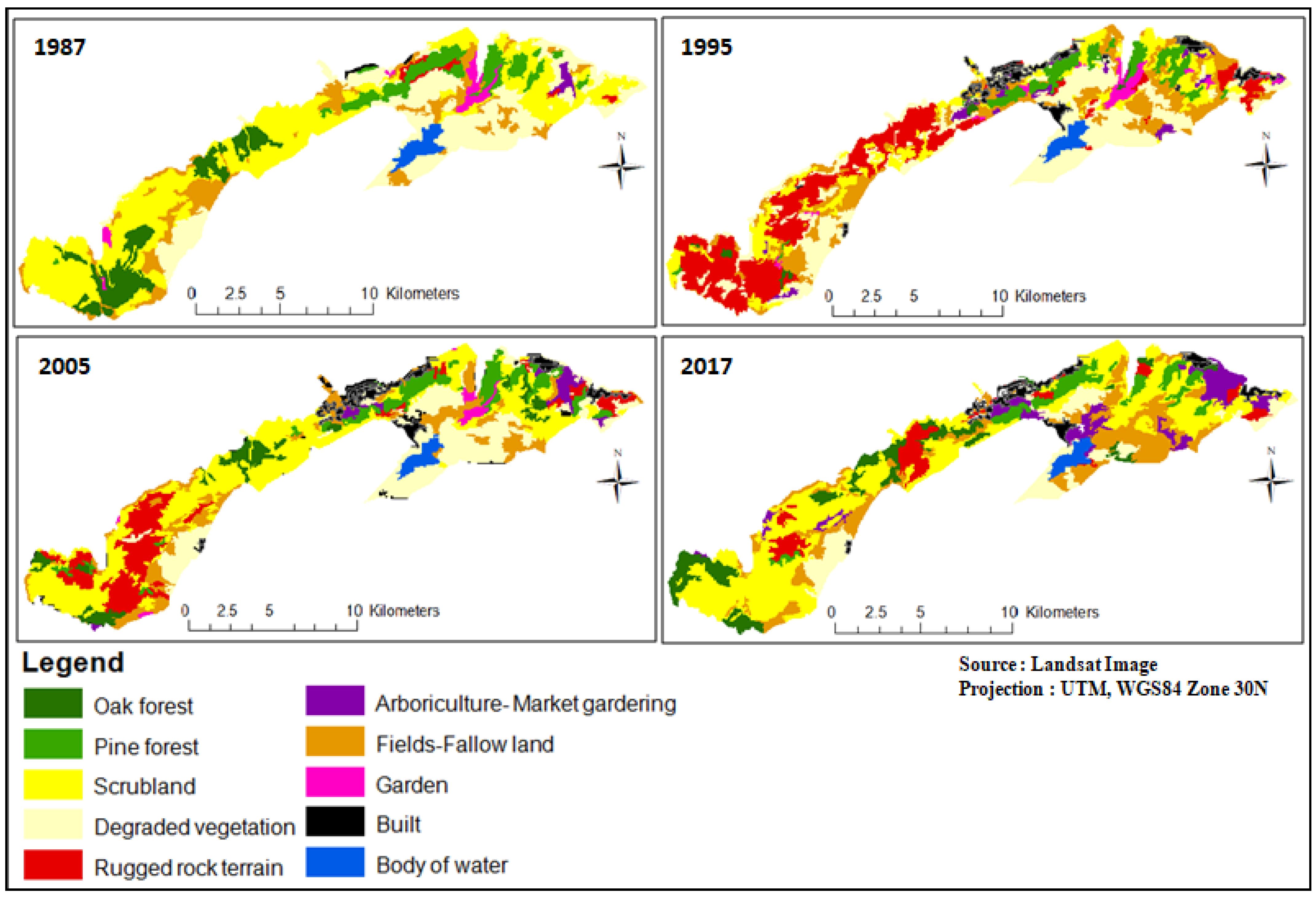
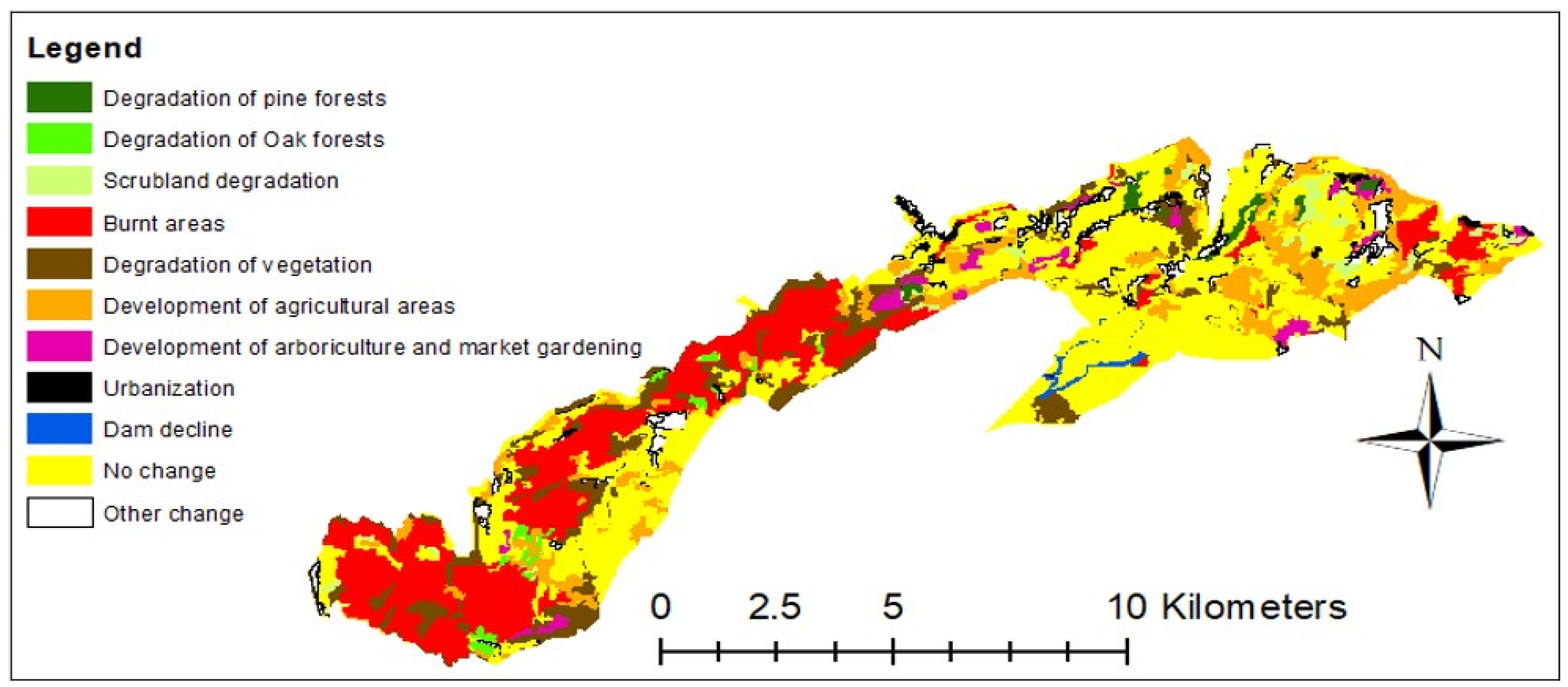
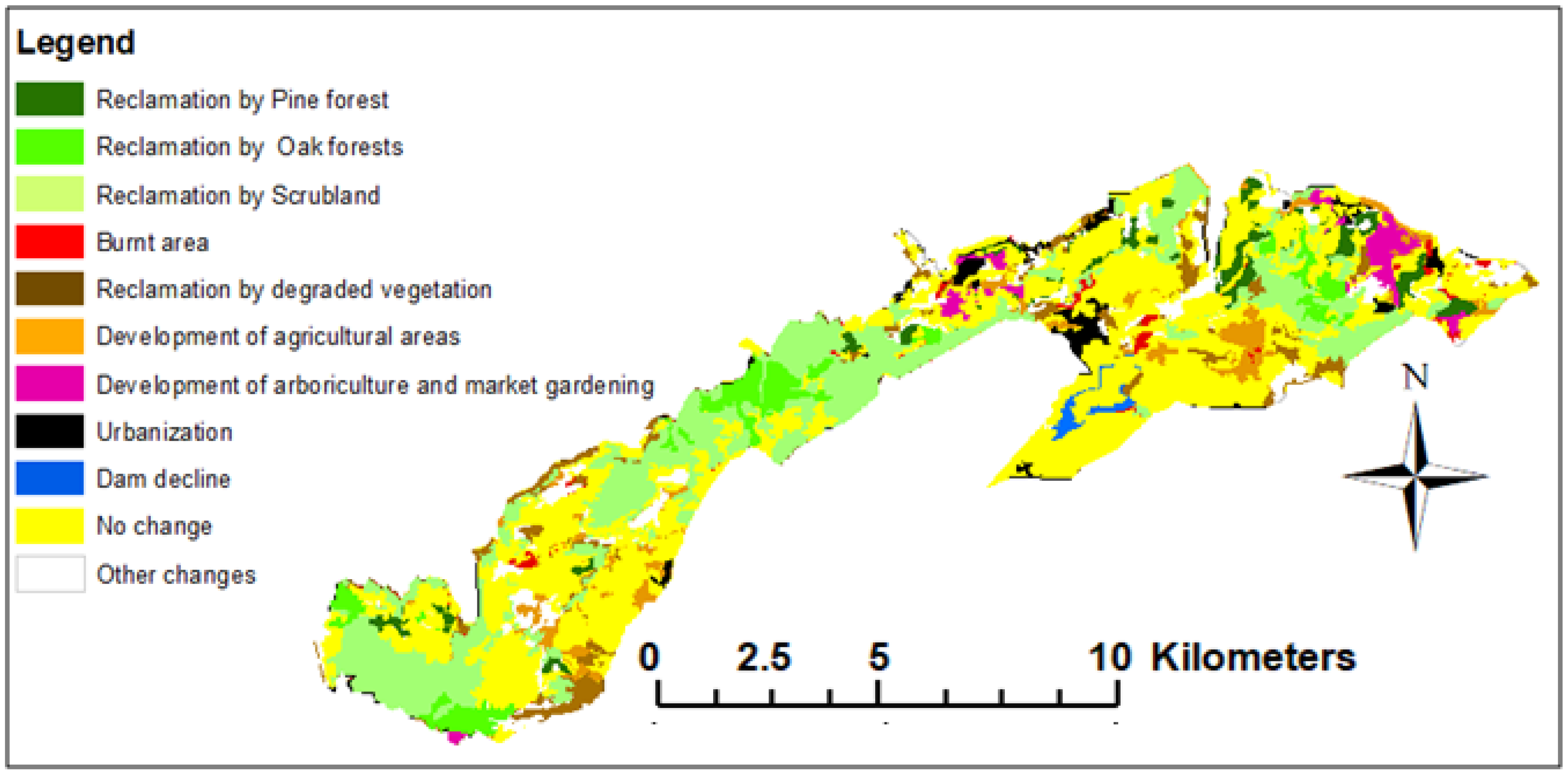

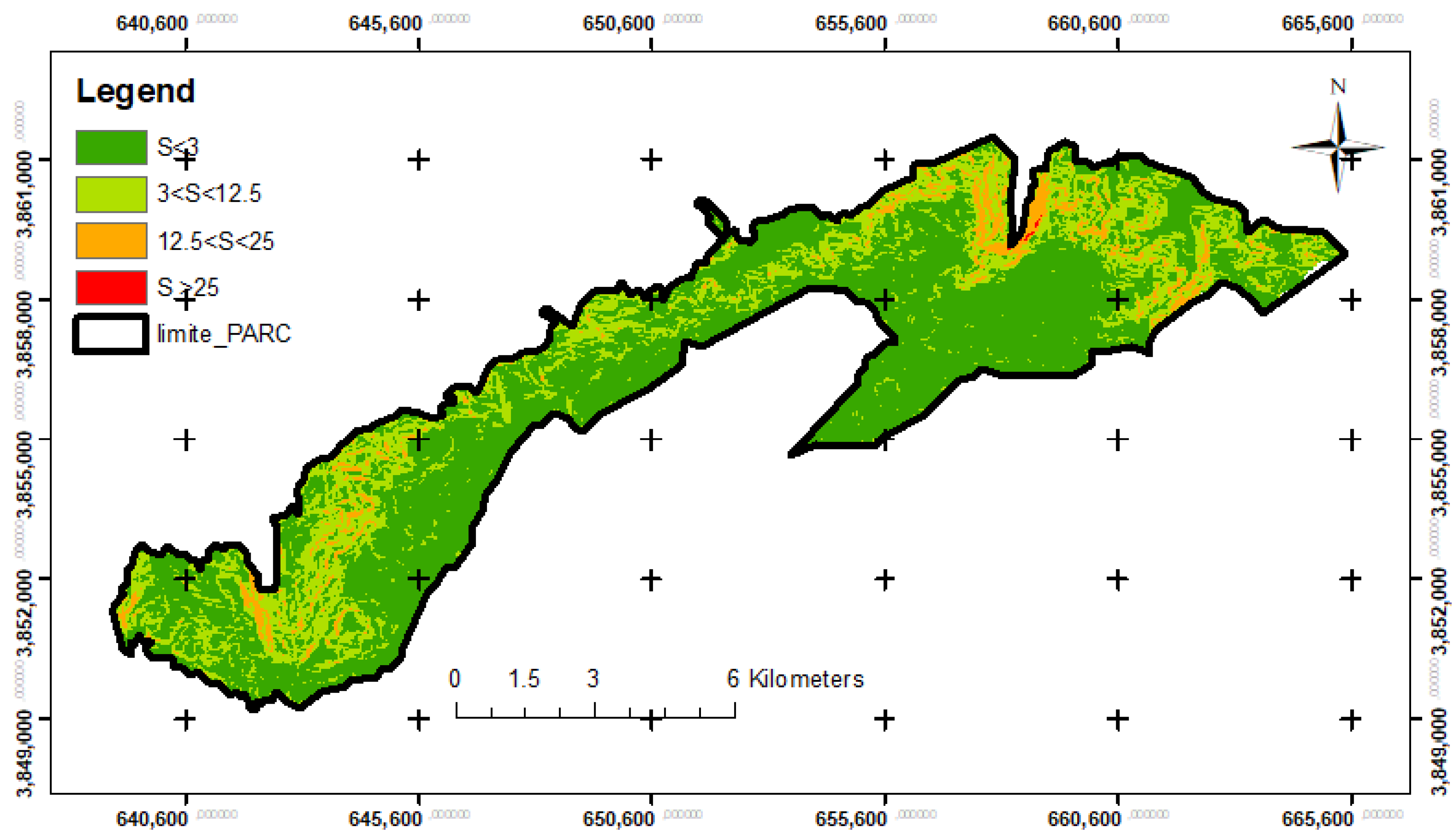
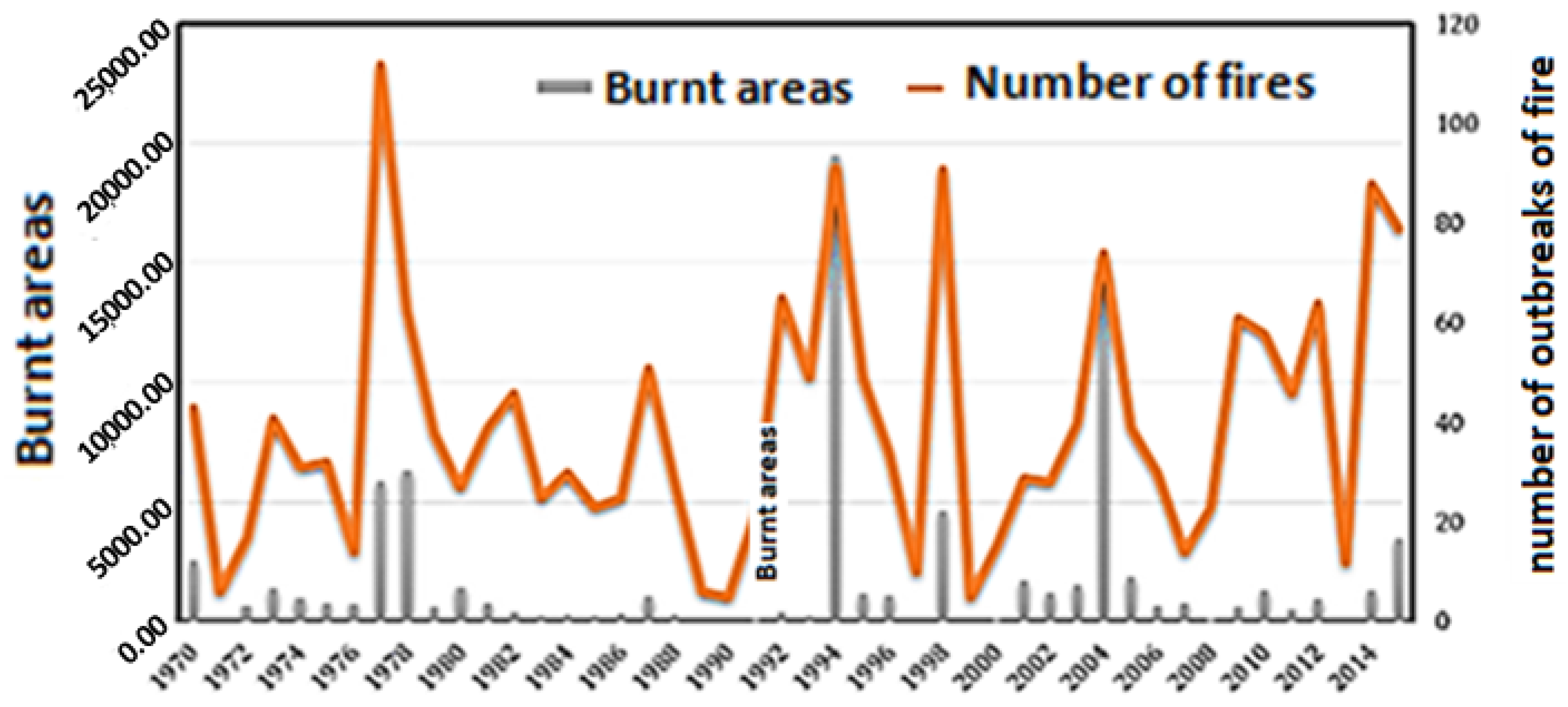
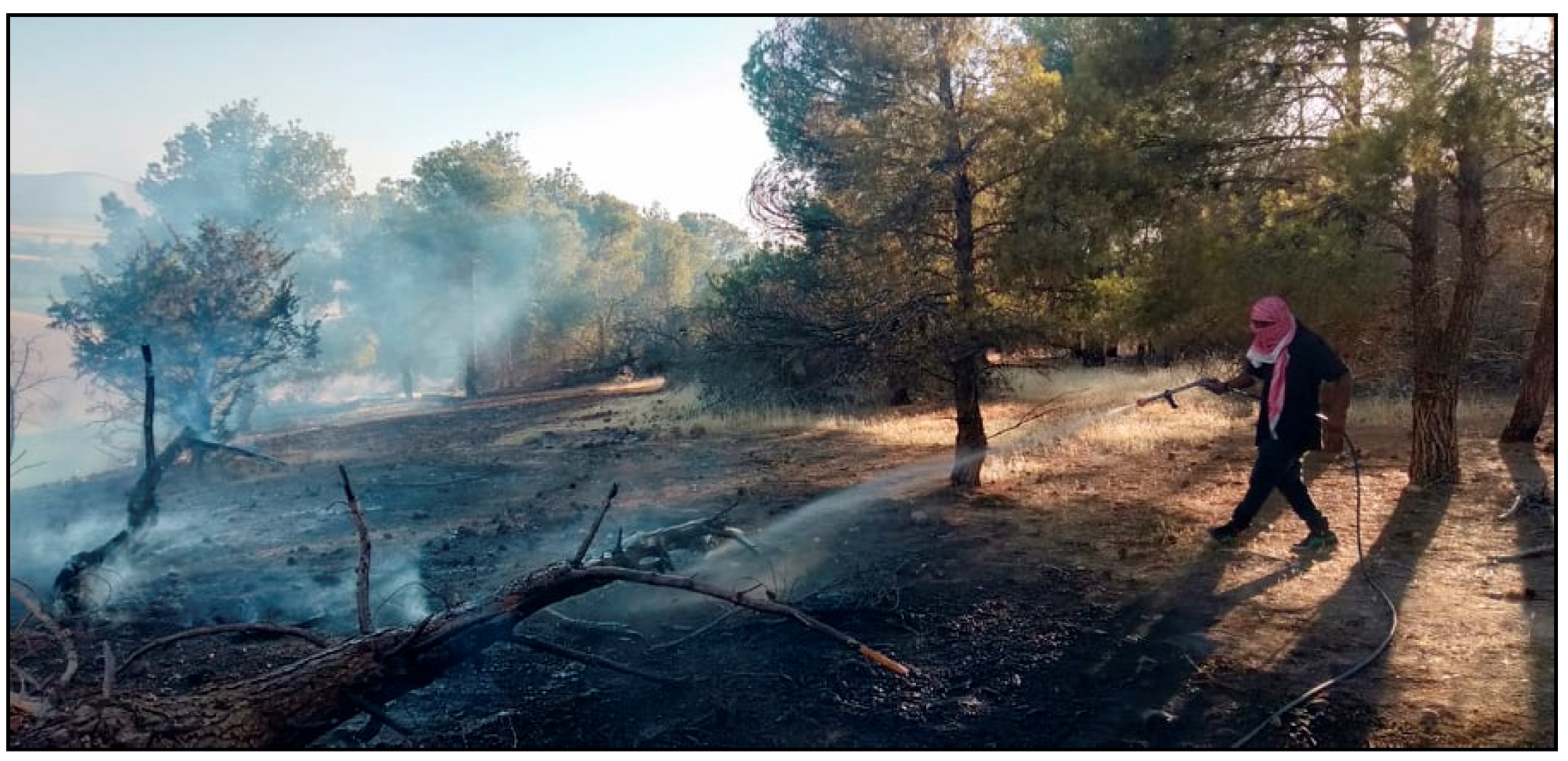

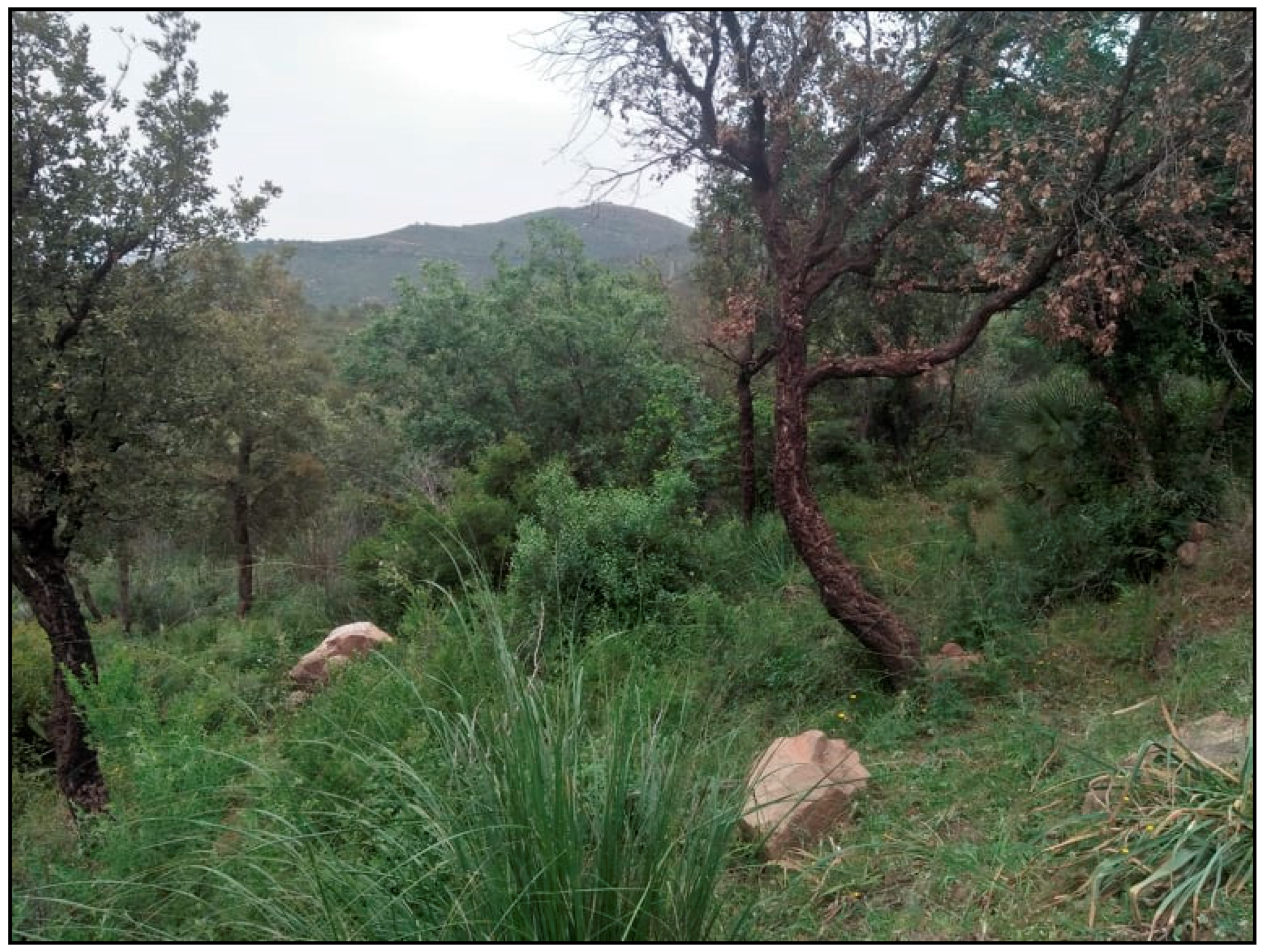

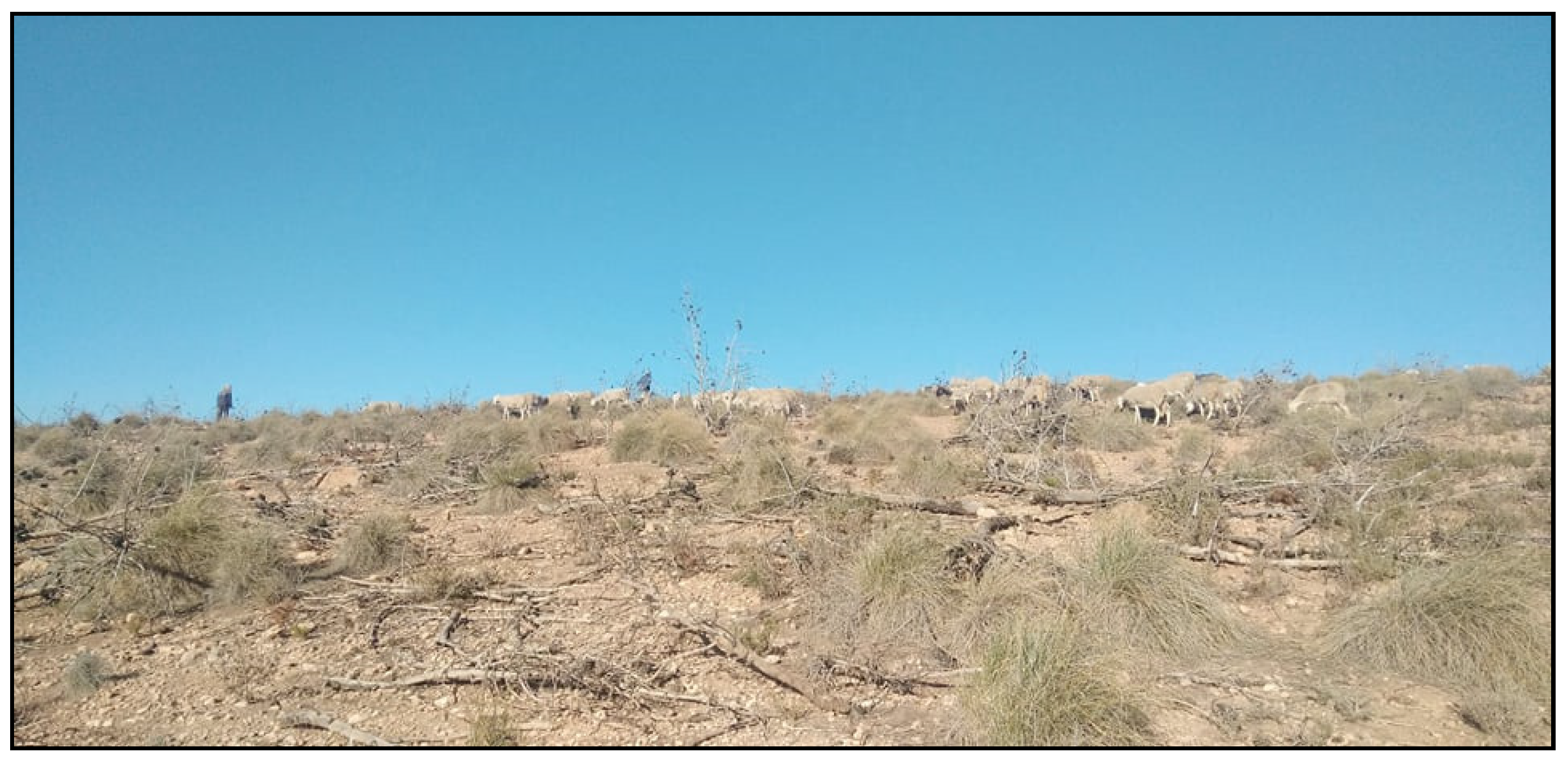

| Date of Acquisition | Satellite | Sensor | Spatial Resolution |
|---|---|---|---|
| 18-05-1987 | Landsat 5 | TM | 30 m |
| 06-04-1995 | Landsat5 | TM | 30 m |
| 19-05-2005 | Landsat7 | ETM+ | 30 m |
| 18-04-2017 | Landsat7 | ETM+ | 30 m |
| LULC Class | Area in Ha and % | Change Rate in % | ||||||||||||||
|---|---|---|---|---|---|---|---|---|---|---|---|---|---|---|---|---|
| 1987 | 1995 | 2005 | 2017 | 87–95 | 95–05 | 05–17 | 87–17 | |||||||||
| Ha | % | Ha | % | Ha | % | Ha | % | Tg | Tc | Tg | Tc | Tg | Tc | Tg | Tc | |
| CO-ZO F | 754.4 | 9 | 61.2 | 0.73 | 453.3 | 5.44 | 751.3 | 9.01 | −91.88 | −31.3 | 640.7 | 19.96 | 65.73 | 4.19 | −0.405 | −0.01 |
| AP F | 625.2 | 7.5 | 541.4 | 6.49 | 668.9 | 8.02 | 472.9 | 5.67 | −13.41 | −1.79 | 23.55 | 2.10 | −29.29 | −2.87 | −24.35 | −0.92 |
| CL-CV S | 3299 | 40 | 1182 | 14.2 | 2639 | 31.7 | 3058 | 36.6 | −64.16 | −12.78 | 123.2 | 8.00 | 15.87 | 1.22 | −7.305 | −0.25 |
| DV | 2137.7 | 26 | 2524 | 30.3 | 1772. | 21.3 | 827.6 | 9.9 | 18.07 | 2.07 | −29.77 | −3.52 | −53.30 | −6.32 | −61.28 | −3.15 |
| B-R-L | 78.84 | 0.9 | 1940 | 23.3 | 1049 | 12.6 | 521.7 | 6.3 | 2360.9 | 39.9 | −45.89 | −6.12 | −50.29 | −5.80 | 561.7 | 6.27 |
| F-F | 1016.5 | 12 | 1478 | 17.7 | 1080 | 13 | 1456 | 17.4 | 45.42 | 4.66 | −26.88 | −3.12 | 34.72 | 2.47 | 43.24 | 1.19 |
| A-MG | 58.5 | 0.7 | 188.5 | 2.26 | 210.8 | 2.53 | 620.4 | 7.44 | 222.15 | 14.57 | 11.84 | 1.11 | 194.32 | 8.96 | 960.4 | 7.84 |
| Gar | 165.9 | 2 | 197.5 | 2.37 | 102.7 | 1.23 | 142.5 | 1.70 | 19.03 | 2.17 | −48.01 | −6.52 | 38.73 | 2.72 | −14.15 | −0.50 |
| Bui | 26.9 | 0.3 | 90.09 | 1.08 | 270.9 | 3.25 | 355.2 | 4.26 | 234.78 | 15.05 | 200.7 | 10.97 | 31.09 | 2.24 | 1219 | 8.57 |
| WB | 174.24 | 2.1 | 133.7 | 1.6 | 88.6 | 1.06 | 131.7 | 1.56 | −23.24 | −3.29 | −33.78 | −4.10 | 48.67 | 3.29 | −24.43 | −0.93 |
| Total | 8337 | 100 | 8337 | 100 | 8337 | 100 | 8337 | 100 | ||||||||
| (a) | 1995 | ||||||||||
| 1987 | CO-ZOF | AP F | CL-CVS | DV | B-R-L | F-F | A-MG | Gar | Bui | WB | Total |
| CO-ZO F | 26.37 | 7.74 | 70.47 | 33.39 | 576.54 | 34.65 | 0.63 | 4.59 | 0 | 0 | 754.38 |
| AP F | 14.58 | 382.32 | 63.54 | 24.66 | 38.25 | 42.3 | 28.35 | 27.36 | 3.87 | 0 | 625.23 |
| CL-CV S | 12.24 | 98.82 | 736.38 | 552.78 | 1219.68 | 560.07 | 67.59 | 45 | 6.39 | 0 | 3298.95 |
| DV | 0 | 8.73 | 85.77 | 1557.81 | 53.46 | 322.29 | 69.48 | 1.71 | 36.9 | 1.35 | 2137.5 |
| B-R-L | 0 | 40.68 | 12.6 | 5.4 | 9 | 4.5 | 3.06 | 2.52 | 1.08 | 0 | 78.84 |
| F-F | 1.17 | 2.7 | 155.7 | 295.92 | 29.97 | 485.82 | 17.19 | 10.71 | 17.28 | 0 | 1016.46 |
| A-MG | 0 | 0.27 | 30.6 | 0 | 0.09 | 15.39 | 2.16 | 9.99 | 0 | 0 | 58.5 |
| Gar | 6.84 | 0.09 | 27.27 | 15.21 | 7.74 | 13.14 | 0 | 95.67 | 0 | 0 | 165.96 |
| Bui | 0 | 0 | 0 | 1.17 | 2.43 | 0 | 0 | 0 | 23.31 | 0 | 26.91 |
| WB | 0 | 0 | 0 | 37.71 | 2.88 | 0 | 0 | 0 | 1.26 | 132.39 | 174.24 |
| Total | 61.2 | 541.35 | 1182.33 | 2524.05 | 1940.04 | 1478.16 | 188.46 | 197.55 | 90.09 | 133.74 | 8337 |
| (b) | 2005 | ||||||||||
| 1995 | CO-ZOF | AP F | CL-CV | DV | B-R-L | F-F | A-MG | Gar | Bui | WB | Total |
| CO-ZO F | 18.9 | 18.72 | 3.51 | 12.87 | 7.11 | 0 | 0.09 | 0 | 0 | 61.2 | |
| AP F | 26.46 | 377.01 | 100.89 | 6.21 | 23.94 | 1.53 | 4.77 | 0 | 0.54 | 0 | 541.35 |
| CL-CV S | 101.25 | 101.43 | 590.04 | 58.32 | 141.93 | 143.1 | 38.61 | 2.07 | 5.49 | 0.09 | 1182.33 |
| DV | 14.67 | 13.59 | 549.36 | 1339.56 | 34.2 | 336.42 | 21.96 | 28.62 | 184.23 | 1.35 | 2523.96 |
| B-R-L | 250.47 | 96.48 | 806.22 | 63.45 | 680.58 | 16.02 | 18.45 | 0.81 | 7.56 | 0 | 1940.04 |
| F-F | 40.41 | 19.8 | 510.12 | 226.89 | 103.05 | 474.39 | 82.17 | 3.69 | 15.3 | 2.34 | 1478.16 |
| A-MG | 0.18 | 12.33 | 48.06 | 16.92 | 24.75 | 48.6 | 31.14 | 0 | 6.48 | 0 | 188.46 |
| Gar | 0 | 29.52 | 23.04 | 0.45 | 28.08 | 37.17 | 11.88 | 67.41 | 0 | 0 | 197.55 |
| Bui | 0.99 | 0 | 7.56 | 14.58 | 0.27 | 13.59 | 1.8 | 0 | 51.3 | 0 | 90.09 |
| WB | 0 | 0 | 0.09 | 46.08 | 0 | 2.79 | 0 | 0 | 0 | 84.78 | 133.74 |
| Total | 453.33 | 668.88 | 2638.89 | 1772.46 | 1049.67 | 1080.72 | 210.78 | 102.69 | 270.9 | 88.56 | 8337 |
| (c) | 2017 | ||||||||||
| 2005 | CO-ZOF | AP F | CL-CV | DV | B-R-L | F-F | A-MG | Gar | Bui | WB | Total |
| CO-ZO F | 214.92 | 14.85 | 145.17 | 0 | 61.83 | 16.56 | 0 | 0 | 0 | 0 | 453.33 |
| AP F | 69.03 | 329.22 | 143.73 | 1.17 | 83.16 | 3.06 | 12.51 | 23.85 | 3.15 | 0 | 668.88 |
| CL-CV S | 295.47 | 57.24 | 1716.57 | 14.49 | 181.53 | 304.2 | 56.52 | 5.4 | 7.38 | 0.27 | 2639.07 |
| DV | 39.51 | 1.26 | 165.24 | 718.38 | 28.44 | 532.26 | 156.06 | 1.44 | 83.52 | 46.35 | 1772.46 |
| B-R-L | 80.37 | 50.22 | 697.05 | 8.28 | 129.06 | 6.75 | 76.05 | 0 | 1.89 | 0 | 1049.67 |
| F-F | 34.74 | 10.44 | 157.41 | 42.84 | 19.89 | 560.79 | 151.02 | 43.47 | 57.78 | 2.34 | 1080.72 |
| A-MG | 8.82 | 9 | 5.22 | 8.37 | 11.97 | 3.78 | 147.06 | 0 | 16.56 | 0 | 210.78 |
| Gar | 0 | 0 | 15.48 | 0 | 0 | 16.02 | 3.15 | 68.04 | 0 | 0 | 102.69 |
| Bui | 8.19 | 0.72 | 12.24 | 34.11 | 5.85 | 12.6 | 12.15 | 0.27 | 184.68 | 0 | 270.81 |
| WB | 0 | 0 | 0 | 0 | 0 | 0 | 5.85 | 0 | 0 | 82.71 | 88.56 |
| Total | 751.05 | 472.95 | 3058.11 | 827.64 | 521.73 | 1456.02 | 620.37 | 142.47 | 354.96 | 131.67 | 8337 |
| Process | Type of Change | 1987–1995 (in %) | 1995–2005 (in %) | 2005–2017 (in %) | |||
|---|---|---|---|---|---|---|---|
| Detail | Process | Detail | Process | Detail | Process | ||
| Stability | Stability | 41.40 | 41.40 | 44.56 | 44.56 | 49.80 | 49.80 |
| Mutation | Type of Forest | 0.27 | 1.29 | 0.54 | 3.25 | 1.01 | 4.90 |
| Farmed versus urban areas | 1.02 | 2.71 | 3.90 | ||||
| Degradation | Forest degradation | 2.30 | 8.93 | 1.33 | 2.03 | 3.48 | 3.65 |
| Scrubland degradation | 6.63 | 0.70 | 0.17 | ||||
| Wildfire | Forest altered by fire | 7.37 | 23.16 | 0.44 | 4.43 | 1.74 | 4.71 |
| Scrubland altered by fire | 14.63 | 1.70 | 2.18 | ||||
| DV*altered by fire | 0.64 | 0.41 | 0.34 | ||||
| Fire on man-made areas | 0.52 | 1.87 | 0.45 | ||||
| Development | Development of the forest | 1.70 | 15.16 | 0.17 | 9.82 | 0.71 | 16.04 |
| Developmentof the scrubland | 8.15 | 2.27 | 4.48 | ||||
| Development of DV* | 5.18 | 6.87 | 9.83 | ||||
| Development of burnt areas | 0.13 | 0.51 | 1.02 | ||||
| Reclamation | From scrubland to forest | 1.33 | 10.06 | 2.43 | 35.91 | 4.23 | 20.90 |
| From DV* to scrubland | 1.13 | 6.59 | 1.98 | ||||
| From DV* to forest | 0.00 | 0.34 | 0.49 | ||||
| Farmabandonment | 6.89 | 11.96 | 4.17 | ||||
| Post-fire recovery | 0.70 | 14.59 | 10.03 | ||||
| Site Number | State Forest | Canton | Location Name | Geographical Coordinates | Area (ha) | Year | Ownership |
|---|---|---|---|---|---|---|---|
| 01 | Hafir | Oued Tlet | Oued Tlet | 34°47′14″ N 1°25′52″ O | 150 | 2009 | TNP |
| 02 | Hafir | Oued Tlet | KoudietHafir | 34°47′00″ N 1°25′39″ O | 05 | 2010 | |
| 03 | Hafir | Oued Tlet | GharLahmame | 34°46′58″ N 1°26′29″ O | 03 | 2009 | |
| 04 | Hafir | Oued Fernane | Oued Fernane 1 | 34°46′55.4″ N 1°26′26.5″ O | 50 | 2005 | Conservation of Tlemcen forests |
| 05 | Hafir | Kréane | dhaya | 34°48′25.55″ N 1°28′06.93″ O | 40 | 2007 | |
| 06 | Zarifet | Zarifet | Zarifet 1 | 34°50’9.0″ N 1°21’32.7″ O | 40 | 2005 | |
| 07 | Zarifet | Zarifet | Zarifet 1 | 34°50’49.8″ N 1°21’5.4″ O | 40 | 2005 | |
| 08 | Zarifet | Zarifet | Zarifet 1 | 34°50’15.1″ N 1°22’49.0″ O | 40 | 2005 | |
| 09 | Zarifet | Zarifet | Zarifet 1 | 34°50’07.6″ N 1°23’08.9″ O | 50 | 2005 |
Publisher’s Note: MDPI stays neutral with regard to jurisdictional claims in published maps and institutional affiliations. |
© 2021 by the authors. Licensee MDPI, Basel, Switzerland. This article is an open access article distributed under the terms and conditions of the Creative Commons Attribution (CC BY) license (https://creativecommons.org/licenses/by/4.0/).
Share and Cite
Bardadi, A.; Souidi, Z.; Cohen, M.; Amara, M. Land Use/Land Cover Changes in the Tlemcen Region (Algeria) and Classification of Fragile Areas. Sustainability 2021, 13, 7761. https://doi.org/10.3390/su13147761
Bardadi A, Souidi Z, Cohen M, Amara M. Land Use/Land Cover Changes in the Tlemcen Region (Algeria) and Classification of Fragile Areas. Sustainability. 2021; 13(14):7761. https://doi.org/10.3390/su13147761
Chicago/Turabian StyleBardadi, Abdelkader, Zahira Souidi, Marianne Cohen, and Mohamed Amara. 2021. "Land Use/Land Cover Changes in the Tlemcen Region (Algeria) and Classification of Fragile Areas" Sustainability 13, no. 14: 7761. https://doi.org/10.3390/su13147761
APA StyleBardadi, A., Souidi, Z., Cohen, M., & Amara, M. (2021). Land Use/Land Cover Changes in the Tlemcen Region (Algeria) and Classification of Fragile Areas. Sustainability, 13(14), 7761. https://doi.org/10.3390/su13147761






